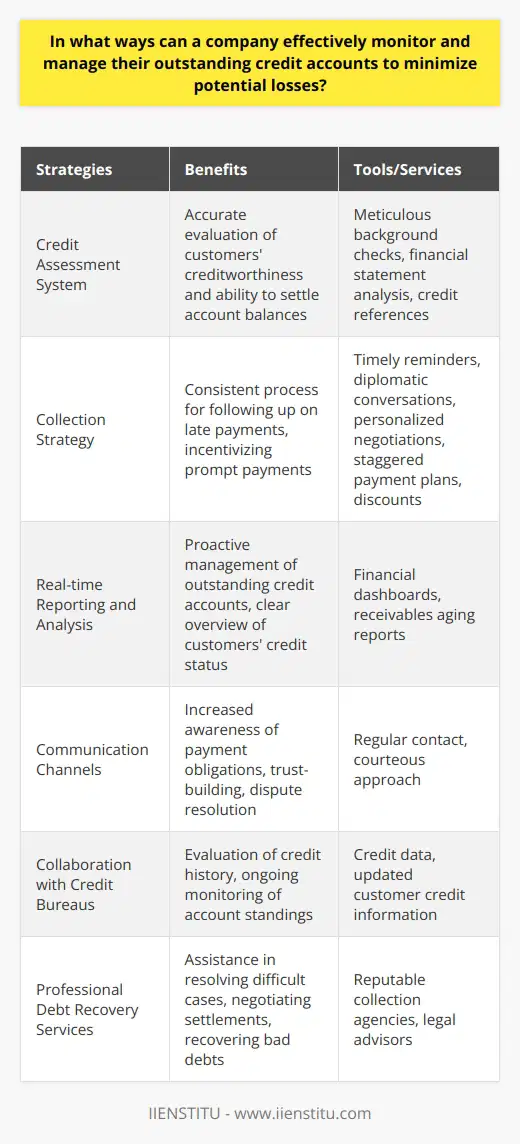
Advantages of Extending Credit
Challenges of Extending Credit
Strategies for Mitigating Risk
Extending credit allows customers to purchase goods and services on credit rather than paying them immediately in cash. It is a common practice in business transactions and is essential for building long-term customer relationships.
Advantages of Extending Credit
There are many advantages to extending credit. The most obvious benefit is increased profitability. By allowing customers to purchase goods and services earlier, businesses can increase their cash flow and generate more revenue. Additionally, customers are more likely to return to companies that offer them credit terms, which can help reduce marketing costs. Finally, extending credit allows businesses to provide enhanced customer service. Customers prefer not to pay in total upfront and would instead make payments over time. As such, offering credit terms can be a powerful way to retain customers and earn loyalty.
Challenges of Extending Credit
While extending credit has many advantages, it can come with specific challenges. One of the most significant risks associated with extending credit is the risk of bad debt. If customers cannot pay their debts, businesses could face substantial losses. Companies must also be able to accurately assess customer creditworthiness to determine if they can repay their debts. This assessment can be both time-consuming and costly.
Strategies for Mitigating Risk
Fortunately, there are several strategies that businesses can use to mitigate the risk of extending credit. The most important is establishing clear credit terms with customers. These terms should be agreed upon in writing before any transactions and should outline the customer’s repayment obligations. Additionally, businesses should consider establishing credit policies that outline the criteria for approving customer applications and the credit limits given to each customer.
In conclusion, extending credit can be a powerful way to build long-term customer relationships. It can increase profitability, improve cash flow, and enhance customer service. However, it is essential to consider the risks associated with extending credit and take steps to mitigate them. Establishing clear credit terms and policies helps protect businesses from the threat of bad debt while still allowing customers to purchase goods and services on credit. Companies can leverage this powerful tool to build strong customer relationships and ensure long-term success by understanding the benefits and risks of extending credit.
Successful businesses extend credit to build relationships that last a lifetime.
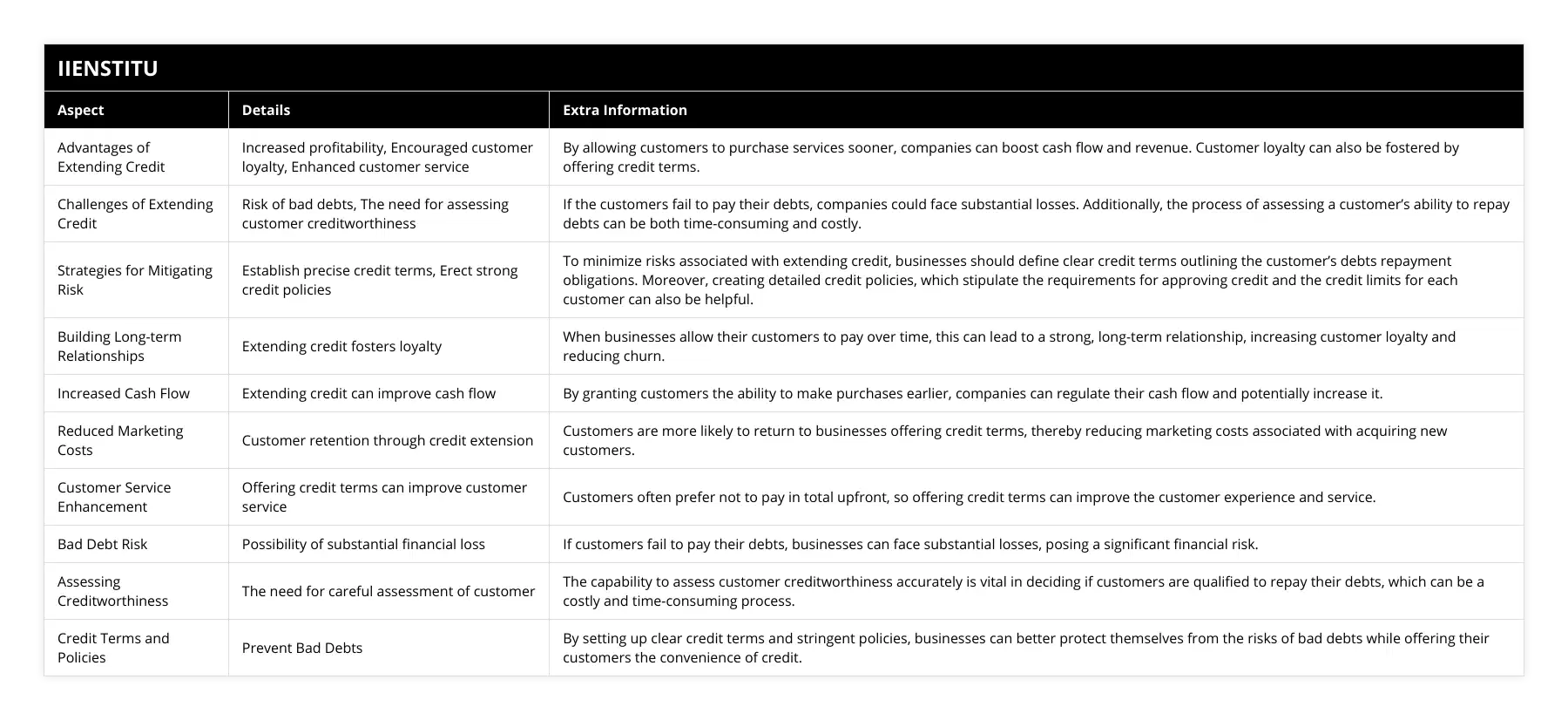
Frequently Asked Questions
How can building trust and longterm relationships with customers increase the likelihood of them using extended credit?
The viability of a business often relies on securing and maintaining customer relationships. Therefore, establishing trust in the customer-business connection is paramount to the venture's success. In addition, building trust and long-term relationships with customers can lead to increased buying behaviors and the likelihood they will use extended credit, both of which are essential to the success of any business and its ongoing operations.
Creating trust should be at the heart of any business endeavor. Research indicates that trust is the glue that holds relationships together and needs to be continually cultivated for a business to succeed. Several key areas can be addressed to help build trust between the customer and the company, such as developing a transparent communication system and actively listening to customers' needs. Ensuring customers know precisely what they will buy and their responsibilities as business customers is integral to building trust. Recommending services and products they may not have known they needed can also help cultivate a relationship of trust between the customer and the business.
Turning customers into repeat buyers and building long-lasting relationships is a significant step a business can take to increase customers' likelihood of utilizing extended credit. Upselling and cross-selling tactics can give customers access to additional services and products through varied payment options and discount offers. For example, offering customers an incentive to refer other customers to the business can generate more business, entice customers to use extended credit, and boost customer loyalty. Rewarding customers for their loyalty with exceptional customer service and exclusive discounts can also increase their trust in the business. Keeping customers informed about upcoming promotions, new services, and discounts will maintain the relationship.
While developing customer loyalty is essential, offering high-quality products and services at competitive prices should remain a top priority. To further ensure customers will use extended credit, businesses should incorporate measures to promote convenience and security regarding payment transactions. Establishing an automated credit system or engaging in a payment installment plan designed to increase access to products and services will also increase customers' likelihood of using extended credit.
In conclusion, building trust and long-term customer relationships will increase their likelihood of using extended credit to purchase products and services. Establishing customer loyalty should be a priority in any business venture, and steps should be taken to create an environment of convenience regarding payment transactions. By utilizing tactics such as upselling and cross-selling, rewarding customer loyalty, and offering special discounts and promotions, businesses can encourage customers to use extended credit and ensure the success of their operations.

What strategies are most successful in managing the outcomes of extended credit while avoiding delinquency and default?
Extended credit has become an essential component of market activity in recent years. Its importance has grown as consumers attempt to obtain desired items and services without depleting monetary reserves. As commendable as this approach is, it does come with certain pitfalls. Without good management, extended credit can lead to delinquency and payment default. Therefore, it is essential to employ effective strategies to manage the effects of extended credit to reduce the risk of such outcomes.
First, one must carefully assess and manage an individual's financial situation. Credit should only be extended to individuals who can realistically handle the payment burden without compromising other financial obligations. A firm grasp of income and expenditures should be present before agreements are made to ensure consumers can honor their financial commitments. Additionally, terms of contracts should be structured to meet the individual's financial capacities and ensure that a consumer's burden is manageable throughout the extended credit window.
In addition to structuring payments around individual financial circumstances, consumer education and awareness can go a long way to assist in preventing delinquency and default. Consumers must be aware of the full extent of their obligations and the consequences of failing to meet them. They should also manage their credit accounts to ensure payment deadlines and balances remain controllable. Understanding variable expenditures and their potential impact can help individuals better manage their accounts.
Finally, non-monetary incentives must be considered an additional feature of comprehensive credit management. Recent research highlights the effectiveness of non-monetary incentives such as reward programs, loyalty discounts, and credits to reduce delinquency and default on payments. For example, rewards can motivate individuals to pay off loans on time with lower interest payments and non-interest charges. Additionally, tips or discounts act as social recognition, increasing consumers' pride in their engagements and their commitment to honoring financial obligations.
Overall, practical strategies for managing extended credit to reduce the risk of delinquency and default should focus on assessing and managing individual financial circumstances, consumer education and awareness, and implementing non-monetary incentives. When coupled with responsible credit access and adherence to loan terms, these strategies will determine the success or failure of extended credit initiatives over a long time.
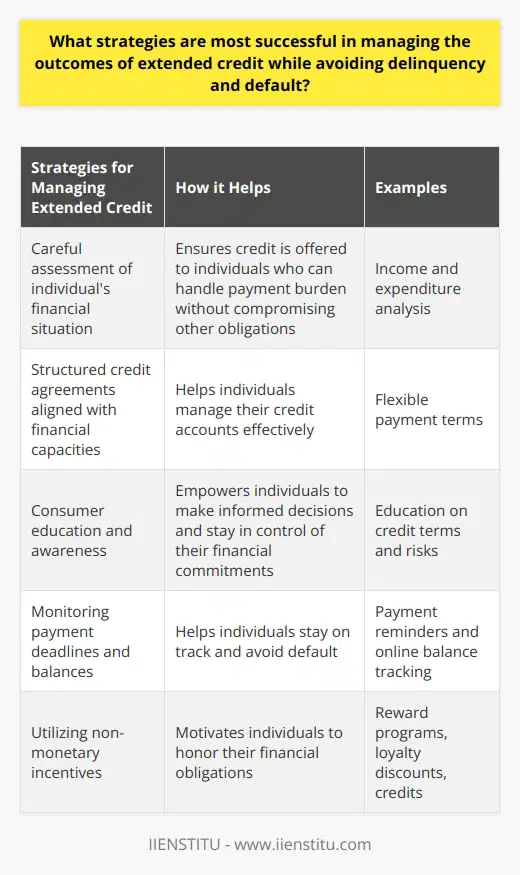
What techniques can be used to improve the success of credit check and risk assessment processes?
In financial management, credit check and risk assessment processes are essential to daily operations with commercial entities. This article aims to examine the techniques that can be used to improve the success of such methods in commercial entities.
One of the most frequently employed techniques for improving the success of credit check and risk assessment processes is developing and implementing automated systems that use rules to detect and identify possible risk cases. Mechanical systems can reduce the manual effort required to process customer requests and minimize the opportunity for human error. Furthermore, by using this approach, organizations can implement a more robust risk management system to better identify and react to risk-level changes over time.
In addition to this, companies can also benefit from the use of analytics-driven approaches to credit check and risk assessment processes. Analytics-driven strategies focus on analyzing historical data to gain insight into the likelihood of experiencing risk in the future. This approach helps identify areas of risk and uncover any problematic behaviors that may have occurred in the past. Companies can then apply corrective actions to mitigate potential losses.
Finally, organizations can also use predictive risk modeling to improve the success of credit and risk assessment procedures. Predictive risk modeling involves the application of complex algorithms and models to historical data to understand the risk of future events better. Companies can then use this information to develop strategies for managing risks in the future.
By incorporating these techniques and approaches into their credit check and risk assessment processes, companies can be better equipped to detect and mitigate risk in the future. Furthermore, organizations need to remain current with the latest developments in financial management to ensure that their credit check and risk assessment processes are as successful and effective as possible.
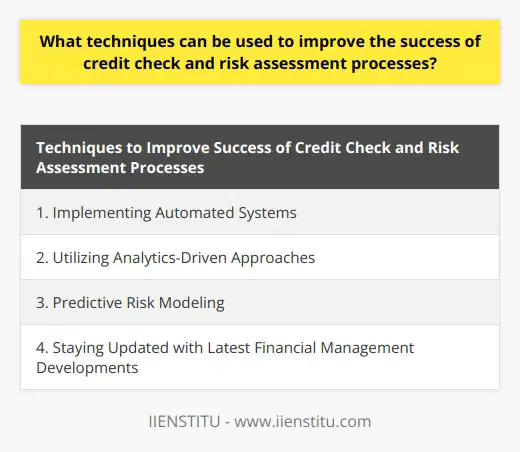
What are the key factors in determining an appropriate credit limit for a customer?
Credit Assessment Process
Before providing credit, businesses must evaluate the creditworthiness of their customers. The credit assessment process involves a comprehensive examination of the customer's financial history, income stability, outstanding debts, and credit score.
Financial History
One primary factor in determining an appropriate credit limit is a customer's financial history. A thorough review of the customer's past behavior helps lenders identify any patterns of late payments or defaults, indicating the borrower's ability to repay debts on time.
Income Stability
Another crucial factor is the stability of the customer's income. A stable and consistent income source increases the likelihood of timely debt repayments. Lenders may request pay stubs, bank statements, or other documents to verify a borrower's income.
Outstanding Debts
Considering a customer's outstanding debts is essential, as it directly impacts their debt-to-income (DTI) ratio. A high DTI ratio may indicate that a borrower is less equipped to take on additional debt. Thus, reviewing existing loans, lines of credit, and credit card balances helps lenders make an informed decision.
Credit Scores
Credit scores are an essential measure of a borrower's creditworthiness. Typically, borrowers with higher credit scores demonstrate responsible financial behavior consistently, making them more likely to receive higher credit limits.
Collateral Analysis
In some cases, lenders require collateral as security for the credit provided. The value of the collateral plays a significant role in determining the credit limit, as it provides assurance to the lender in case of default.
Risk Management Policies
Lastly, lenders' internal risk management policies also influence the credit limit. These policies may impose caps on credit exposure to specific industry sectors, regions or instruments, or establish minimum credit scores and maximum debt-to-income ratios.
Conclusion
Determining an appropriate credit limit for a customer requires a holistic assessment of the borrower's financial situation, considering their financial history, income stability, outstanding debts, credit scores, collateral, and lenders' risk management policies. By carefully evaluating these factors, businesses can effectively mitigate risk and ensure the successful management of credit portfolios.
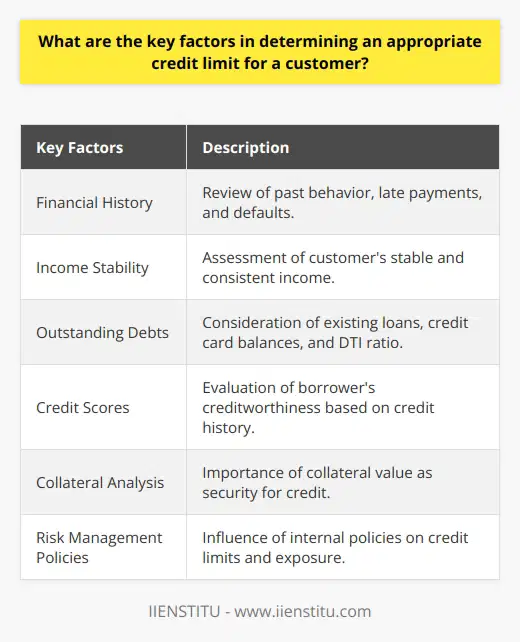
How do varying payment terms impact the overall risk and reward of extending credit?
Impact on Risk
Varying payment terms can significantly impact the overall risk associated with extending credit. Shorter payment terms, such as net 15 or net 30, require repayment within 15 or 30 days respectively. These terms mitigate risk by limiting the time during which a debtor can default or a business can experience financial distress. Conversely, longer payment terms, such as net 60 or 90, increase risk as they allow debtors more time to potentially default on their loans or face financial difficulties.
Credit Evaluation
To assess the risk associated with varying payment terms, it is vital to evaluate a debtor's creditworthiness. This process involves reviewing their financial history, including credit scores, payment patterns, and overall debt levels. Creditworthy debtors are deemed likely to meet their financial obligations even in unfavorable circumstances, thereby reducing the risk of extending credit. On the other hand, debtors with poor creditworthiness pose a higher risk of default or late payments.
Risk Diversification
Another approach to mitigating risk while also exploring the benefits of extending credit is by diversifying credit portfolios. This involves offering credit in different segments of the market, which can distribute the risk of default across a broader range of debtors. This strategy assists in balancing risk exposure and maintaining the ability to harvest potential returns from a mix of creditworthy and subprime borrowers.
Effect on Reward
The rewards associated with extending credit increase when offering longer payment terms, as they often come with higher interest rates or fees. Longer payment terms allow creditors to offset the risk associated with extending credit by charging higher rates, which can boost overall returns. Additionally, the opportunity for repeat business can arise when flexible payment terms are offered, thereby building a loyal customer base that leads to increased profitability over time.
Conclusion
In conclusion, varying payment terms present a trade-off between risk and reward when extending credit. Shorter payment terms tend to reduce risk, while longer terms may generate higher rewards. To strike a balance, credit providers must evaluate each debtor's creditworthiness and consider diversifying credit portfolios to manage risks more effectively. Ultimately, offering flexible payment terms while maintaining a robust risk management strategy can enhance the overall profitability of extending credit.
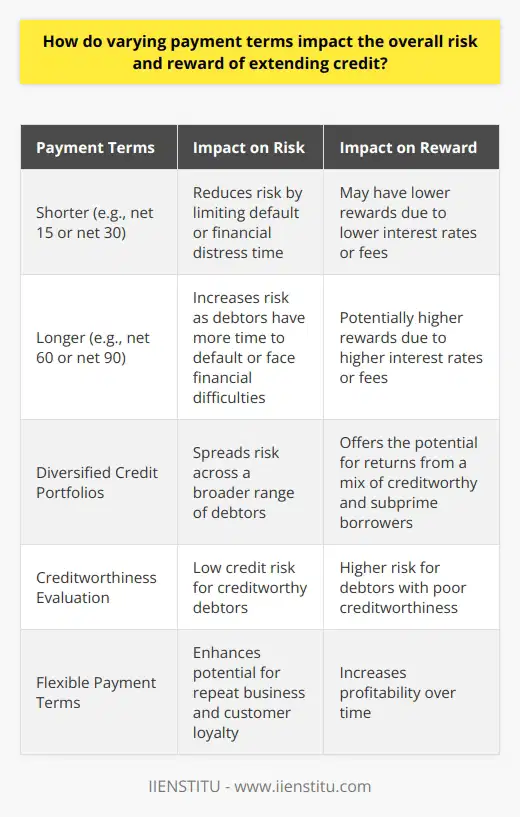
In what ways can a company effectively monitor and manage their outstanding credit accounts to minimize potential losses?
Efficient Credit Assessment and Monitoring
The starting point for managing outstanding credit accounts is an efficient credit assessment system. It allows companies to identify creditworthy customers, evaluate their credit limits, and set appropriate terms of credit. Meticulous background checks, financial statements analysis, and credit references enable a company to assess customers' ability to settle their account balances.
Structured Collection Strategy
A well-structured collection strategy enables streamlined management of outstanding credit accounts. Following a consistent process, including timely reminders, diplomatic conversations, and personalized negotiations, facilitates the timely collection of pending payments. Implementing staggered payment plans and offering discounts for prompt payments incentivizes customers to prioritize their account settlements.
Real-time Reporting and Analysis
Utilizing real-time reporting and analysis tools aids in the proactive management of outstanding credit accounts. Comprehensive financial dashboards and detailed receivables aging reports provide a clear overview of the credit status of customers. Monitoring customers' financial health and ensuring that their ability to pay does not deteriorate will help minimize potential losses.
Effective Communication Channels
Establishing clear and open communication channels with customers is essential for outstanding credit account management. Maintaining regular contact can increase customers' awareness of their payment obligations while building trust and credibility. A courteous approach and willingness to resolve disputes can also facilitate timely payments and foster long-term business relationships.
Collaboration with Credit Bureaus
Collaborating with credit bureaus enables companies to access valuable credit data, relevant to evaluating customers' credit history and risk profiles. Regularly updating customer credit information helps in the ongoing monitoring of account standings. Furthermore, reporting delinquent accounts to credit bureaus can be an effective deterrent for non-payment.
Professional Debt Recovery Services
Engaging professional debt recovery services can be a useful tool in managing non-performing outstanding credit accounts. Reputable collection agencies and legal advisors can help resolve difficult cases, negotiate settlements, and recover bad debts. Outsourcing these activities can save time and resources, while reducing credit losses.
In conclusion, effective monitoring and management of outstanding credit accounts are crucial for minimizing potential losses. Adopting robust credit assessment and monitoring practices, utilizing real-time reporting tools, fostering effective communication, and collaborating with credit bureaus and professional debt recovery services can all contribute to the successful management of outstanding credit accounts.
